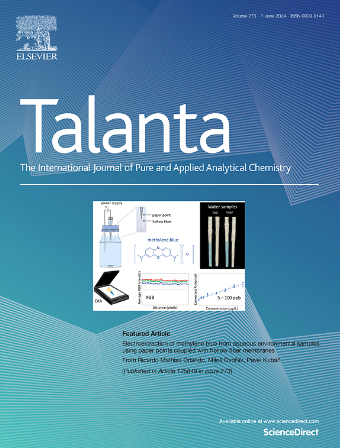Single-laser fabrication of nitrogen-doped porous graphene from chitosan/polyimide for the electrochemical determination of dextromethorphan
IF 5.6
1区 化学
Q1 CHEMISTRY, ANALYTICAL
引用次数: 0
Abstract
A simple and effective disposable electrode was developed for the electrochemical detection of dextromethorphan (DEX) in pharmaceutical and forensic samples. Polyimide was treated with chitosan before being used to create the electrode through single-laser fabrication of nitrogen-doped porous graphene. The laser power and speed were optimized to achieve optimal performance. Scanning electron microscopy, energy dispersive X-ray, Raman and Fourier transform infrared spectroscopy were used to characterize the morphology of fabricated materials. The electrochemical characterization of electrodes was studied by using cyclic voltammetry and electrochemical impedance spectroscopy. The electrochemical behavior of DEX was investigated using cyclic voltammetry and analytical measurements were performed using differential pulse voltammetry. Differential pulse voltammetry was optimized in terms of buffer type, buffer pH, potential pulse, time pulse, potential step, scan rate, deposition potential, and deposition time. In the optimal condition, two linear ranges were observed, ranging from 2.5 to 25 μmol L−1 and 25 to 400 μmol L−1. The limit of detection (LOD) was 1.8 μmol L−1. The developed method produced a statistically significant agreement with high-performance liquid chromatography for the determination of DEX.

求助全文
约1分钟内获得全文
求助全文
来源期刊

Talanta
化学-分析化学
CiteScore
12.30
自引率
4.90%
发文量
861
审稿时长
29 days
期刊介绍:
Talanta provides a forum for the publication of original research papers, short communications, and critical reviews in all branches of pure and applied analytical chemistry. Papers are evaluated based on established guidelines, including the fundamental nature of the study, scientific novelty, substantial improvement or advantage over existing technology or methods, and demonstrated analytical applicability. Original research papers on fundamental studies, and on novel sensor and instrumentation developments, are encouraged. Novel or improved applications in areas such as clinical and biological chemistry, environmental analysis, geochemistry, materials science and engineering, and analytical platforms for omics development are welcome.
Analytical performance of methods should be determined, including interference and matrix effects, and methods should be validated by comparison with a standard method, or analysis of a certified reference material. Simple spiking recoveries may not be sufficient. The developed method should especially comprise information on selectivity, sensitivity, detection limits, accuracy, and reliability. However, applying official validation or robustness studies to a routine method or technique does not necessarily constitute novelty. Proper statistical treatment of the data should be provided. Relevant literature should be cited, including related publications by the authors, and authors should discuss how their proposed methodology compares with previously reported methods.
 求助内容:
求助内容: 应助结果提醒方式:
应助结果提醒方式:


